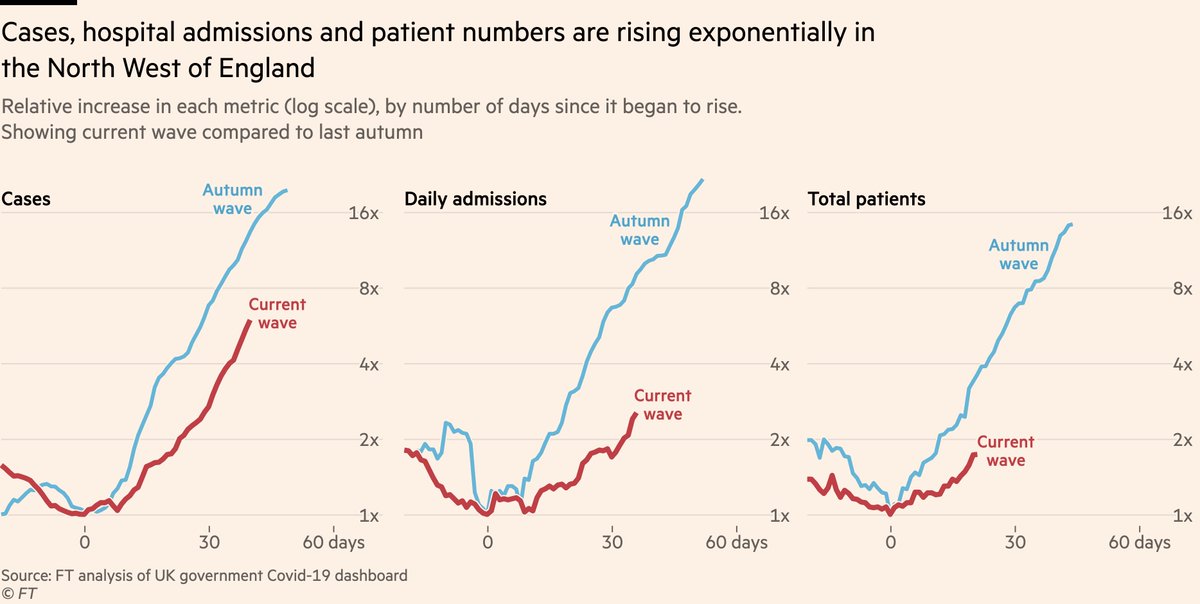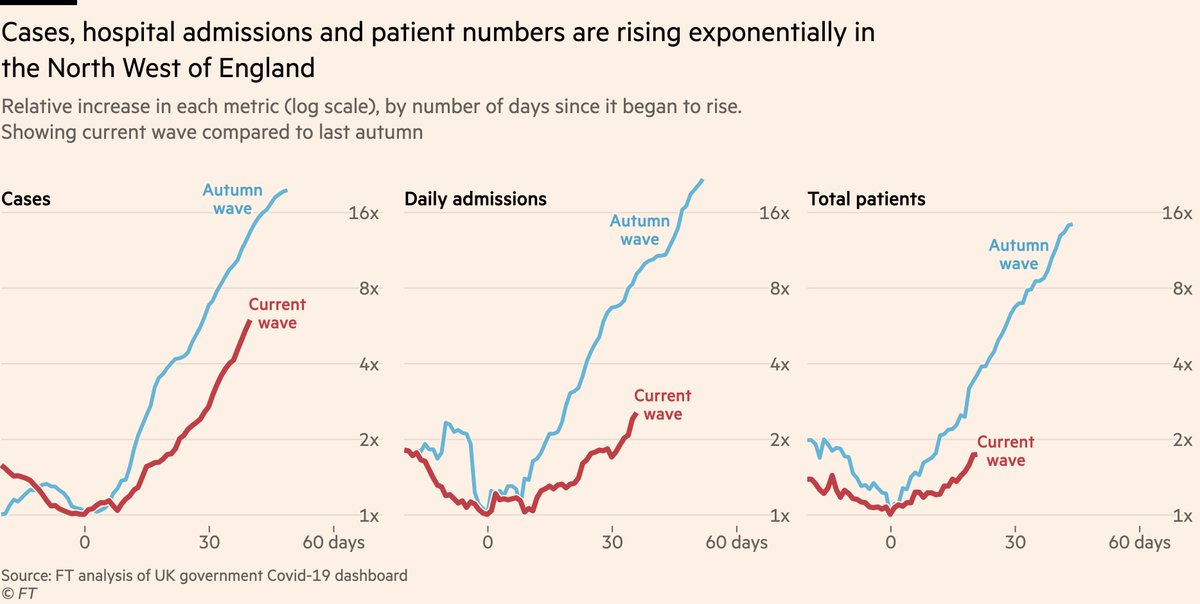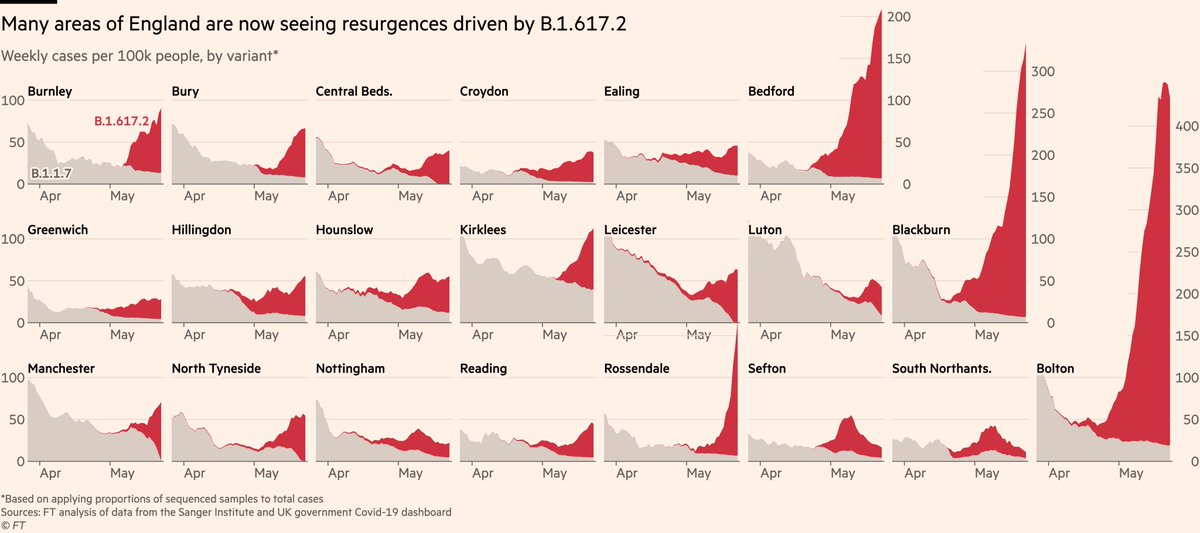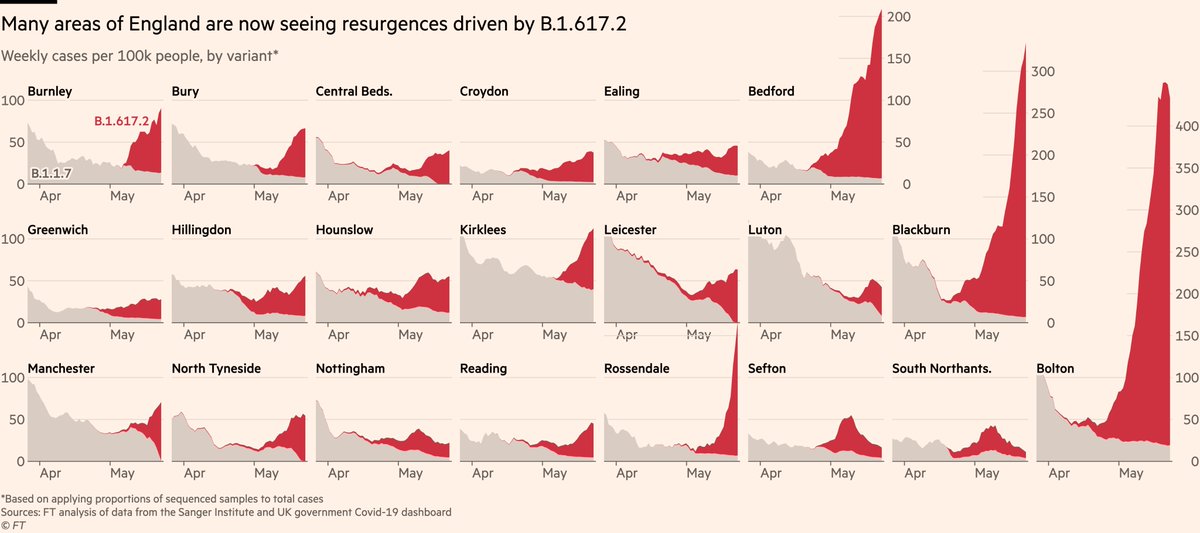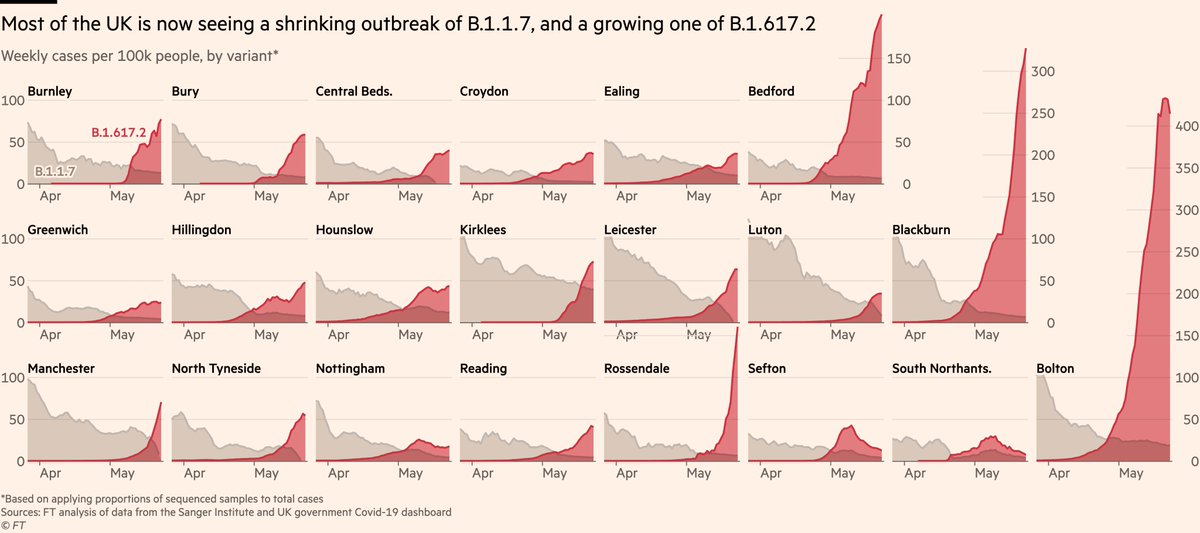
NEW: UK’s full reopening is set to be postponed by a month due to resurgence in cases — and now hospitalisations — fuelled by the Delta variant.
Story ft.com/content/fa7c25…
Thread: first up, that core data: UK admissions, patients & ventilator bed numbers now all climbing
Story ft.com/content/fa7c25…
Thread: first up, that core data: UK admissions, patients & ventilator bed numbers now all climbing
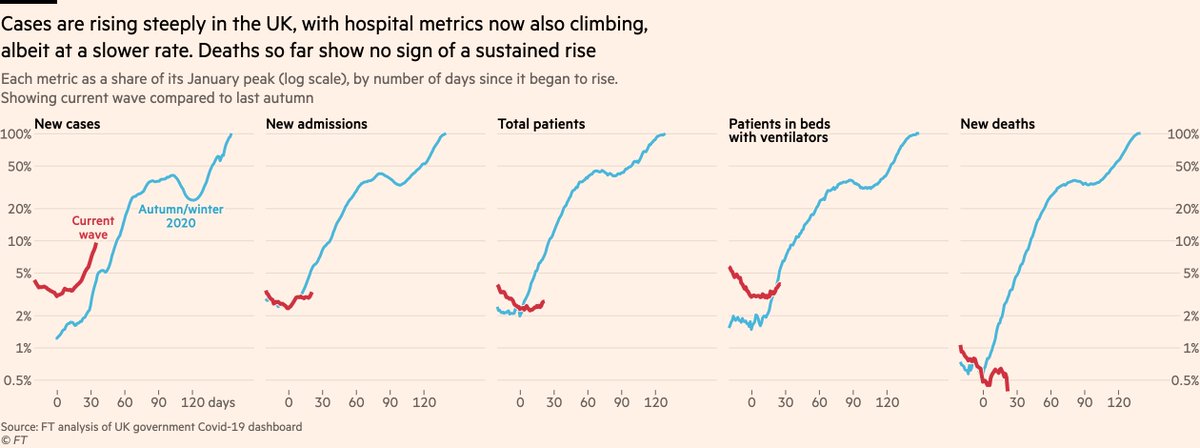
An obvious initial point to make: whilst the rate of increase in cases is just as steep as it was last autumn, the hospital metrics are climbing more slowly.
This is good news (!), but it comes with nuances that point in both an optimistic and pessimistic direction.
This is good news (!), but it comes with nuances that point in both an optimistic and pessimistic direction.
The pessimistic: until recently admissions in Wales and Northern Ireland were falling steeply, which was countering rises elsewhere and making UK totals flatter than they would otherwise be.
In the last week, admissions have risen in every UK region but one: the East of England.
In the last week, admissions have risen in every UK region but one: the East of England.
If we look at the same metrics for England alone we get steeper rises. There’s no way of looking at the central three red lines on this chart and saying they’re not trending upwards. Shallower than cases, but rising nonetheless. 

And here’s where it gets most pessimistic (don’t worry, optimism coming soon):
North West England has been UK’s canary down the coal mine as far as Delta is concerned, and the picture there is ... not good. Hospital metrics are rising almost as steeply as they did last year
North West England has been UK’s canary down the coal mine as far as Delta is concerned, and the picture there is ... not good. Hospital metrics are rising almost as steeply as they did last year

If those trends spread to the rest of the country, the growth rate in hospitalisations elsewhere in the UK is also likely to pick up.
Now, that might not happen — it could be there are specific conditions in the NW that have made it fare especially badly — but it may well happen
Now, that might not happen — it could be there are specific conditions in the NW that have made it fare especially badly — but it may well happen
I said there would also be optimism, and here it is:
The age profile of the current resurgence remains much younger than past waves, and we can see this with both cases and hospitalisations.
The age profile of the current resurgence remains much younger than past waves, and we can see this with both cases and hospitalisations.
First, cases: so far in current resurgence, younger people have been far more likely to get infected than older (💉), and that alone means we would now expect far fewer deaths-per-case
75% fewer, to be precise, which may already mean ~750 lives saved in England in the last month
75% fewer, to be precise, which may already mean ~750 lives saved in England in the last month

Next, hospital admissions.
Whereas during last autumn’s wave admissions initially rose at the same rate across all age groups, they’re now rising fast among young adults (age 25-44) but slowly if at all among the most elderly.
Whereas during last autumn’s wave admissions initially rose at the same rate across all age groups, they’re now rising fast among young adults (age 25-44) but slowly if at all among the most elderly.

The result: a larger share of younger patients than last autumn, but far fewer elderly. An analysis of age-specific hospitalisation-fatality-rates across England’s epidemic to date suggests this will weaken the link between admission and death this time around, by about a third. 

So for a given number of cases during this wave, we should see fewer hospitalisations, and for a given number of admissions, we should see fewer deaths.
The links are certainly not broken, but they are weaker.
The links are certainly not broken, but they are weaker.
The rise in hospitalisations on its own is clearly sufficient reason to re-evaluate the June 21 full reopening date, but there’s one more piece of information that I think shows why the postponement was justified:
Even though the UK’s vaccination rollout has been among the fastest and most comprehensive worldwide, there are gaps: around *2 million* over-50s in the UK have still not had a single dose. Many of these people are still highly vulnerable to the current wave. 
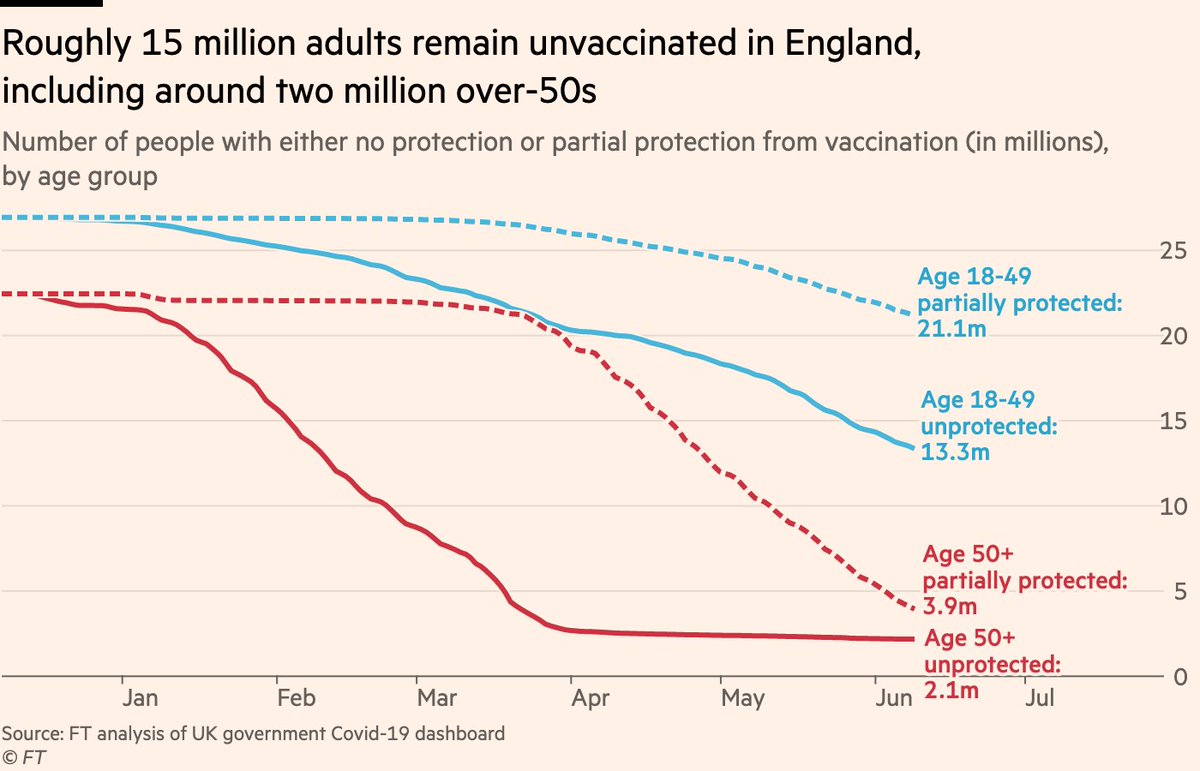
Added to that are ~13 million unvaccinated younger adults, and another ~8m partially vaxxed younger adults (👋), so you can see a more transmissible variant still has plenty of fuel to prolong its spread.
With that in mind, I don’t see how June 21 could have gone ahead.
With that in mind, I don’t see how June 21 could have gone ahead.
So, to conclude:
• Third wave of hospital admissions clearly underway
• Data still suggest this wave should be less lethal
• But no clear sign yet of current wave subsiding
• And still millions unvaccinated
• Postponement seems the logical move
• Third wave of hospital admissions clearly underway
• Data still suggest this wave should be less lethal
• But no clear sign yet of current wave subsiding
• And still millions unvaccinated
• Postponement seems the logical move
Finally, some notes:
• Big thanks to Dan Howdon for guidance with the age-specific CFRs and HFRs that show this wave likely to be less lethal
• A nudge to @KasperKepp who will hopefully now accept that UK admissions are rising? We shall see...
• Big thanks to Dan Howdon for guidance with the age-specific CFRs and HFRs that show this wave likely to be less lethal
• A nudge to @KasperKepp who will hopefully now accept that UK admissions are rising? We shall see...
I’ll keep tracking all of these metrics as we go on, and will also be taking a look at the situation with Delta away from the UK.
As ever, comments and questions welcome.
Enjoy your Fridays, folks.
As ever, comments and questions welcome.
Enjoy your Fridays, folks.
• • •
Missing some Tweet in this thread? You can try to
force a refresh


